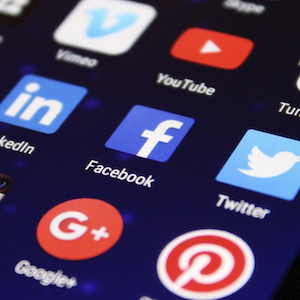The influence of social media on patients’ perception of aesthetic treatment outcome: satisfaction with tattoo removal, a model

Accepted: 22 January 2022
HTML: 4
All claims expressed in this article are solely those of the authors and do not necessarily represent those of their affiliated organizations, or those of the publisher, the editors and the reviewers. Any product that may be evaluated in this article or claim that may be made by its manufacturer is not guaranteed or endorsed by the publisher.
Objective. The patients’ degree of satisfaction with tattoo removal is variable and does not always correspond to clinical objectivity. As we have noticed an increasing role of social media in influencing patients, this study evaluates how much they can affect satisfaction with picosecond laser (PSL) tattoo removal. Materials and Methods. Twenty-seven patients were treated with PSL for the removal of professional black tattoos. Two groups of patients were identified: those already being treated in our institute or referred by other physicians (Group 1) and those who came after a search on social media (Group 2). Clinical improvement was evaluated 8 weeks after the final laser session and patients’ satisfaction was assessed. Results. Clinical results were homogeneous in both groups, but patients reported worse subjective Global Aesthetic Improvement Scale than those reported by clinicians, especially in Group 2 (P=0.035), while Group 1 was globally more satisfied (P<0.001). Conclusions. The role of social media in influencing patients’ perceptions and expectations can affect their degree of satisfaction. The explanation before treatments is fundamental to clarify what can really be expected from laser sources, especially for those influenced by social media.
Kluger N, Misery L, Seité S, et al. Regrets after tattooing and tattoo removal in the general population of france. J Eur Acad Dermatol Venereol 2019;33:e157-e159.
Gurnani P, Williams N, Al-Hetheli G, et al. Comparing the efficacy and safety of laser treatments in tattoo removal: a systematic review. J Am Acad Dermatol 2020:S0190-9622(20)32349-5.
Pedrelli V, Azzopardi E, Azzopardi E, et al. Picosecond laser versus historical responses to Q-switched lasers for tattoo treatment. J Cosmet Laser Ther 2020;22(4-5):210-214.
Hutton Carlsen K, Esmann J, Serup J. Laser surgeon, client education, and satisfaction with tattoo removal. Curr Probl Dermatol 2017;52:124-131.
Gantenbein L, Navarini AA, Maul LV, et al. Internet and social media use in dermatology patients: Search behavior and impact on patient-physician relationship. Dermatol Ther 2020;33(6):e14098.
Ranpariya V, Chu B, Fathy R, et al. Instagram influencer definitions and the need for dermatologist engagement on social media. J Am Acad Dermatol 2020;83:e449-e450.
Ranpariya V, Chu B, Fathy R, et al. Dermatology without dermatologists? Analyzing Instagram influencers with dermatology-related hashtags. J Am Acad Dermatol 2020;83(6):1840-1842.
Hutton Carlsen K, Esmann J, Serup J. Tattoo removal by Q-switched yttrium aluminium garnet laser: client satisfaction. J Eur Acad Dermatol Venereol 2017;31:904-909.
Bencini PL, Cazzaniga S, Tourlaki A, et al. Removal of tattoos by q-switched laser: variables influencing outcome and sequelae in a large cohort of treated patients. Arch Dermatol 2012;148:1364-9.
Fitzpatrick TB. The validity and practicality of sun-reactive skin types I through VI. Arch Dermatol 1988;124:869-871.
Narins RS, Brandt F, Leyden J, et al. A randomized, double‐blind, multicenter comparison of the efficacy and tolerability of Restylane versus Zyplast for the correction of nasolabial folds. Dermatol Surg 2003;29:588–595.
Shah SD, Aurangabadkar SJ. Newer trends in laser tattoo removal. J Cutan Aesthet Surg 2015;8:25–29.
Brauer JA, Reddy KK, Anolik R, et al. Successful and rapid treatment of blue and green tattoo pigment with a novel picosecond laser. Arch Dermatol 2012;148:820-3.
Herd RM, Alora MB, Smoller B, et al. A clinical and histologic prospective controlled comparative study of the picosecond titanium:sapphire (795 nm) laser versus the Q-switched alexandrite (752 nm) laser for removing tattoo pigment. J Am Acad Dermatol 1999;40(4):603-6.
Wu DC, Goldman MP, Wat H, et al. A systematic review of picosecond laser in dermatology: evidence and recommendations. Lasers Surg Med 2021;53(1):9-49.
Bernstein EF, Schomacker KT, Basilavecchio LD, et al. A novel dual-wavelength, Nd:YAG, picosecond-domain laser safely and effectively removes multicolor tattoos. Lasers Surg Med 2015;47(7):542-548.
Schoenberg E, Shalabi D, Wang JV, et al. Public social media consultations for dermatologic conditions: an online survey. Dermatol Online J 2020;26:13030/qt5ht4k2rh.
Tamminga MA, Lipoff JB. Understanding sunscreen and photoprotection misinformation on parenting blogs: A mixed-method study. Pediatr Dermatol 2021;38:88-91.
Copyright (c) 2022 the Author(s)

This work is licensed under a Creative Commons Attribution-NonCommercial 4.0 International License.
PAGEPress has chosen to apply the Creative Commons Attribution NonCommercial 4.0 International License (CC BY-NC 4.0) to all manuscripts to be published.





 https://doi.org/10.4081/dr.2022.9440
https://doi.org/10.4081/dr.2022.9440



